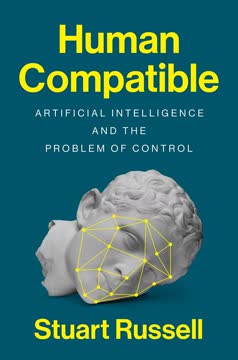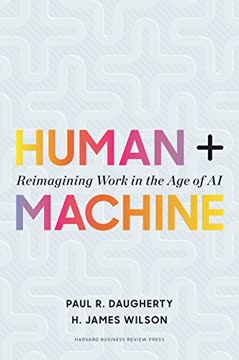Key Takeaways
1. AI's True Potential: Augmentation, Not Just Automation
A widespread misconception is that AI systems will gradually replace humans in one industry after another.
Beyond replacement. The prevailing narrative often pits humans against machines, predicting widespread job displacement due to AI-powered automation. However, the true, transformative power of AI lies not in replacing human workers wholesale, but in complementing and augmenting human capabilities. This shift moves us beyond the "second wave" of business transformation focused on automation, into a "third wave" centered on adaptive processes.
Symbiotic relationships. Leading companies are discovering that the greatest gains in business performance occur when people and machines work in symbiotic relationships. Machines excel at repetitive tasks, analyzing vast datasets, and handling routine cases, while humans bring judgment, creativity, and the ability to resolve ambiguous information. This collaboration allows each to push the other to achieve what neither could do alone, leading to unprecedented outcomes.
Reimagining work. This human-plus-machine approach fundamentally changes the nature of work. Instead of merely automating existing, linear processes, organizations are reimagining how work gets done, fostering fluid, adaptive teams where humans and AI systems collaborate. This leads to continuous adaptation based on real-time data and co-creation, rather than rigid, predefined steps, unlocking new levels of efficiency and innovation.
2. The "Missing Middle" is Where Human-Machine Collaboration Thrives
The simple truth is that machines are not taking over the world, nor are they obviating the need for humans in the workplace.
A dynamic space. The "missing middle" describes the vast, dynamic space where humans and smart machines collaborate, leveraging each other's strengths to achieve superior results. This concept challenges the simplistic "human versus machine" dichotomy, revealing a rich landscape of hybrid activities that are largely overlooked in traditional economic analyses of jobs. It's where the most significant value from AI investments is generated.
Complementary strengths. Humans excel at tasks requiring intuition, judgment, creativity, and dealing with ambiguity, while machines are unparalleled in speed, scale, and data processing. The missing middle is where these distinct capabilities converge. For example:
- AI handles tedious data collection and preliminary analysis in claims processing.
- Human claims processors focus on complex cases requiring judgment and customer interaction.
- AI generates myriad design options, while human designers curate and refine based on aesthetic taste.
New roles emerge. This collaborative paradigm gives rise to entirely new job functions and reimagined processes. Companies like Stitch Fix exemplify this, where machine learning algorithms narrow down clothing options, and human stylists apply their expertise and intuition to finalize personalized selections, constantly learning from customer feedback. This dynamic interaction is key to unlocking unprecedented productivity and innovation.
3. Generative AI: A Game-Changer Expanding the Missing Middle
Generative AI, with its great promise of increasing productivity and creativity, reaffirms the need for leaders to continue on the path we laid out in the first edition.
Unprecedented capabilities. Generative AI marks a significant leap in AI development, moving beyond analysis and prediction to create entirely new content—text, images, audio, code, and more—from simple prompts. This capability, exemplified by models like ChatGPT and AlphaFold2, is transforming human-AI collaboration by enabling groundbreaking creativity and productivity across all sectors.
Democratizing AI. The emergence of large language models (LLMs) and natural language interfaces means AI is no longer exclusive to data scientists. Almost anyone in any organization can now put AI to work simply by communicating with it in everyday language. This widespread accessibility vastly expands the "missing middle," pushing the potential for human-machine collaboration into every corner of organizations and redefining existing jobs.
Massive impact. The implications for businesses are profound. Our analysis indicates that 40% of all US working hours across industries have the potential to be impacted by LLMs, with significant effects on business functions like banking (72% of hours) and insurance (68%). This technology will lead to a sweeping reimagining of business, creating new roles and redefining industry leadership by unleashing the next stage of human potential.
4. Reimagining Business Processes for Exponential Gains
The paradox is that although these processes are not standardized or routine, they can repeatedly deliver better outcomes.
Beyond static processes. The third wave of business transformation, driven by AI, moves organizations beyond static, sequential processes towards fluid and adaptive systems. Unlike the mechanistic automation of the past, which yielded incremental efficiencies, reimagined processes leverage real-time data and human-machine co-creation to achieve exponential improvements in performance.
Dynamic adaptation. Consider the evolution from traditional GPS to Waze:
- Traditional GPS: Digitized static maps, providing fixed directions.
- Waze: Combines AI algorithms with real-time user data (traffic, accidents) to create dynamic, optimized maps that reroute drivers mid-course.
Similarly, businesses are moving from rigid assembly lines to flexible human-machine teams that continuously adapt to new data and market conditions, enabling hyper-customization and faster time-to-market.
Strategic reinvention. Reimagining processes requires a fundamental shift in mindset, a "rupture with the world we take for granted." This involves breaking down jobs into tasks, identifying those suitable for AI automation or augmentation, and then redesigning workflows around these new capabilities. Companies like Best Buy are using generative AI to transform customer service, not just by automating FAQs, but by empowering agents with real-time insights, leading to more personalized and efficient customer experiences.
5. New Human Roles: Training, Explaining, and Sustaining AI
These new jobs are not simply replacing old ones. They are entirely novel positions, requiring skills and training never needed before.
Humans as AI's teachers. As AI systems become more sophisticated and humanlike, new categories of jobs emerge that focus on developing and managing their behavior. These "trainer" roles are crucial for imbuing AI with human traits, such as empathy, personality, and cultural awareness. Examples include:
- Empathy Trainers: Teaching chatbots to respond with compassion and depth (e.g., Koko's work with Siri/Alexa).
- Personality Trainers: Shaping AI's brand persona (e.g., Apple's Siri writers).
- Worldview & Localization Trainers: Ensuring AI is sensitive to global cultural differences.
Bridging the black box. The increasing opacity of complex AI algorithms necessitates "explainer" roles. These professionals bridge the gap between technologists and business leaders, ensuring transparency and accountability in AI decision-making. With regulations like the EU's "right to explanation," these roles are becoming critical. Examples include:
- Algorithm Forensics Analysts: Investigating AI mistakes to understand causes and correct behavior.
- Transparency Analysts: Classifying AI systems based on their explainability and auditability.
- Explainability Strategists: Deciding which AI technologies are best suited for applications based on accuracy vs. explainability trade-offs.
Ensuring responsible AI. "Sustainer" roles are vital for ensuring AI systems function properly, ethically, and safely. They act as guardians against unintended consequences and promote trust. Examples include:
- Context Designers: Considering business, user, and cultural factors in AI system design.
- AI Safety Engineers: Anticipating and mitigating harmful AI behaviors.
- Ethics Compliance Managers: Upholding human values and morals in AI deployment, addressing biases (e.g., in loan approvals or search results).
- Machine Relations Managers: Overseeing AI system performance, similar to HR for human workers.
6. AI Empowers Humans with Superpowers: Amplify, Interact, Embody
These technologies are not a threat, they’re more like superpowers.
Amplifying human potential. AI tools are not just automating tasks; they are enhancing human capabilities, leading to new levels of productivity, creativity, and decision-making. This "amplification" allows workers to focus on higher-value, more human-centric activities. Examples include:
- Generative Design Software (Autodesk): Expanding design possibilities beyond human imagination, allowing designers to curate from thousands of AI-generated options (e.g., the Elbo Chair, Airbus partition).
- Medical Imaging AI (Philips Illumeo): Providing radiologists with contextual patient data and automatically suggesting tools, speeding up diagnoses and improving accuracy.
- Augmented Reality Glasses: Overlaying digital instructions on a worker's field of view, boosting efficiency in maintenance and training (e.g., wind turbine wiring, Boeing assembly).
Seamless interaction. AI assistants are employing advanced interfaces, particularly natural language processing (NLP), to facilitate interactions between people or on behalf of people, operating at scale. This "interaction" capability makes AI ubiquitous in customer service and knowledge work. Examples include:
- Conversational AI (SEB Bank's Aida, Google Agent Assist): Handling customer queries, guiding users, and learning from human experts to provide seamless, personalized service.
- AI-powered Legal Assistants (Harvey, CoCounsel): Accelerating legal research, drafting documents, and summarizing information for lawyers, freeing them for strategic decisions.
- Financial Advisor AI (Morgan Stanley): Providing instant access to vast research databases, allowing advisors to focus more on client engagement.
Embodying physical capabilities. AI combined with sensors, motors, and actuators allows robots to share physical workspaces with humans, extending human physical capabilities. This "embodiment" is transforming industrial and logistical operations. Examples include:
- Collaborative Robots (Mercedes-Benz, BMW): Working alongside humans on assembly lines, handling heavy lifting and repetitive tasks, while humans perform dexterous, judgment-based work, increasing flexibility and reducing strain.
- Warehouse Robots (Amazon, Symbotic): Autonomously transporting goods and optimizing storage, reducing human walking distances and improving efficiency.
- Delivery Drones (Zipline, Manna): Extending human delivery capabilities to remote or challenging areas, delivering medical supplies or groceries.
7. Leaders Must Cultivate a Culture of Trust and Experimentation
What matters is companies that don’t continue to experiment or embrace failure eventually get in the position where the only thing they can do is make a Hail Mary bet at the end of their corporate existence.
Embrace experimentation. In the rapidly evolving AI landscape, leaders cannot simply replicate best practices; they must foster a culture of rigorous, structured experimentation. This means designing, funding, and running tests with a "build-measure-learn" approach, even if many fail. Amazon's Amazon Go and Dash Cart initiatives, initially tested with employees, exemplify this, pushing technological boundaries while gathering crucial feedback.
Foster a blended culture. Integrating AI requires establishing an organizational culture that promotes and enforces responsible AI, while also building trust among employees. Leaders must:
- Install Guardrails: Define clear boundaries for AI behavior to prevent unintended or harmful outcomes (e.g., Microsoft Bing's chatbot incident).
- Use Human Checkpoints: Design processes where humans can monitor, understand, and intervene in AI decisions, reducing the "black box" effect and fostering trust (e.g., analytics dashboards for robot performance).
- Minimize "Moral Crumple Zones": Ensure that when AI systems fail, the responsibility and negative consequences don't unfairly fall on human workers or customers, which erodes trust (e.g., ride-sharing app failures).
Address anxieties transparently. Employee anxieties about job security and the "uncanny valley" effect (discomfort with near-human robots) must be addressed. Leaders should communicate clearly that AI is meant to augment, not replace, and invest in reskilling. Providing employees with agency over AI systems, as seen with petroleum engineers optimizing oil wells, increases trust and adoption.
8. A Robust Digital Core is the Foundation for AI-Driven Reinvention
A brittle, legacy digital core will hold a company back and impair its business success, while a modern digital core positions a company for success.
The enterprise backbone. A modern digital core is the essential technology and platform foundation that drives a company's business functions. It's not just about isolated IT systems, but a composable, agile, and interoperable landscape that integrates cloud, data, and AI to accelerate growth, reimagine experiences, and optimize operations, with security by design.
Dynamic data supply chain. The lifeblood of this core is a dynamic data supply chain, treating data as a continuously evolving enterprise-wide asset. This involves:
- Capturing Variety: Incorporating structured, semi-structured, and unstructured data (text, images, audio, sensor data).
- Increasing Velocity: Prioritizing and accelerating "hot" (time-critical) data while efficiently storing "cold" data (e.g., Facebook's tiered photo storage).
- Enabling Discovery: Democratizing access to insights, allowing non-technical users to leverage LLMs to query vast company knowledge bases in natural language.
Strategic data management. Companies must move beyond traditional, siloed data management to intelligent cloud platforms. This enables them to:
- Leverage Synthetic Data: Generate artificial data that mimics real-world characteristics, crucial for training large-scale generative AI models when real data is scarce or sensitive.
- Widen Access: Integrate internal data with external sources like syndicated data or open data, as seen with Beiersdorf using Nielsen data for product insights.
- Fill the Missing Middle: Design specific roles (e.g., data hygienists, data supply-chain officers) to manage data quality, prevent biases, and ensure the continuous improvement of AI systems through feedback loops.
9. Eight "Fusion Skills" Define the Future of Work
Each skill draws on the fusion of human and machine talents within a business process to create better outcomes than working independently.
New competencies for a hybrid world. The age of human-machine fusion demands a novel set of "fusion skills" that combine human and machine capabilities. These skills are not about technical programming, but about relational competence, enabling continuous learning and improved process performance.
The eight fusion skills:
- Rehumanizing Time: Skillfully redirecting time freed by AI towards more human activities like interpersonal interactions, creativity, and complex decision-making (e.g., doctors spending more time with patients, sales associates building relationships).
- Responsible Normalizing: Responsibly shaping the public and internal perception of human-machine collaboration, fostering acceptance and understanding (e.g., Audi's "piloted driving" campaign, Fiat's canteen cobot).
- Judgment Integration: Deciding a course of action when a machine is uncertain or lacks necessary context, blending human intuition with AI insights (e.g., Capital One's credit risk analysis, Shell's Sensabot operators).
- Intelligent Interrogation: Knowing how to ask AI systems smart questions across levels of abstraction to gain needed insights (e.g., prompt engineers, retail executives probing pricing algorithms).
- Bot-Based Empowerment: Effectively working with AI assistants and agents to extend personal and professional capabilities, creating "superpowers" (e.g., freelancers using bots for administrative support, job seekers leveraging AI for resumes).
- Holistic Melding: Developing robust mental models of AI assistants and agents, allowing humans to project their skills into machines and vice versa, leading to seamless collaboration (e.g., surgeons operating robotic tools, Kindred AI's human "pilots").
- Reciprocal Apprenticing: Humans and machines continuously learning from each other in a virtuous cycle of improvement, where people act as role models for AI and learn from AI's insights (e.g., financial firm's senior members training new recruits and AI algorithms).
- Relentless Reimagining: The rigorous discipline of creating new processes and business models from scratch, rather than merely automating old ones (e.g., Capital One's "Garage" innovation center, Stitch Fix's personalized shopping).
10. Responsible AI is Non-Negotiable for Sustainable Value
For businesses, the surest safeguards lie in a human-centric approach, aligned with human values, to the design and deployment of AI, governed by robust responsible AI at every turn.
Mitigating inherent risks. While generative AI offers immense promise, it also carries significant risks, including hallucination, bias, lack of explainability, intellectual property infringement, and excessive carbon emissions. Addressing these requires a proactive, human-centric approach to AI design and deployment.
A comprehensive framework. Responsible AI involves intentional actions to create value while building trust and protecting against potential harms. Key principles include:
- Human by Design: Always considering AI's impact on people.
- Fairness: Ensuring equitable treatment and mitigating bias.
- Transparency, Explainability, Accuracy: Disclosing AI use and understanding its outputs.
- Safety: Mitigating harm to life, property, and environment.
- Accountability: Clear governance and responsibility for AI decisions.
- Compliance, Data Privacy, Cybersecurity: Adhering to laws and protecting data.
- Sustainability: Considering environmental impact (e.g., carbon emissions).
Systematic operationalization. Despite widespread acknowledgment of its importance, few companies have fully operationalized responsible AI. This requires:
- Establishing clear AI governance and principles.
- Conducting continuous AI risk assessments.
- Enforcing systematic mitigation and testing.
- Continually monitoring for compliance.
- Assessing AI's broad impact (value, workforce, environment, privacy).
- Building a responsible AI culture through training and communication.
Collective action. Beyond individual companies, addressing risks like deepfakes, cybercrime, and autonomous warfare requires collective efforts involving businesses, governments, policy makers, and civil society. Educating the public and ensuring responsible use are paramount to shaping a better future with AI.
Last updated:
Review Summary
Human + Machine receives mixed reviews, with an average rating of 3.63/5. Some praise its insights on AI's impact on work and business processes, highlighting the concept of human-machine collaboration. Critics argue it lacks depth, originality, and balance, often rehashing known AI concepts. The book is seen as more suitable for executives and those new to AI, offering case studies and a framework for AI adoption. However, some reviewers find it overly optimistic and potentially outdated in the rapidly evolving AI landscape.
Similar Books







Download PDF
Download EPUB
.epub digital book format is ideal for reading ebooks on phones, tablets, and e-readers.





